Ideological teachings, the Victory Museum, and how the Korean War reminds of the current Ukraine conflict.
Ideological teachings, the Victory Museum, and how the Korean War reminds of the current Ukraine conflict.
By Stary Shakhtyor
Every day in the evening and morning in Pyongyang, the melody of the song dedicated to Kim Il-sung plays on loudspeakers. The whole city listens to this tune. The synopsis of the song is as follows. A Korean (North Korean, to be more precise) soldier is lost, having been separated from his fellow soldiers, and being in enemy territory, that is, in modern terms, in the ‘grey’ zone. He yearns and sings: “Where are you, honoured commander?”
To watch the skyline of Pyongyang with the song being played, follow the link: https://dzen.ru/video/watch/66e5af66170e8f117f1ea16d?share_to=link (Video)
At night, the light was cut off (and immediately switched on) several times. The thunderstorm was noisy and sparkling. In the morning it rained for a long time, not like in Russia, it was a continuous Asian downpour. The ocean, I guessed, because the ocean is close by! The vapours accumulate into huge clouds over the boundless water to pour down in torrents on the ground.
After breakfast, the official part – we were lectured on the revolutionary ideas of the third of the Kims – Kim Jong-un. He has them too, has his own definite course. If Grandpa preached self-reliance – Juche, Dad made the army the leading class – Songun, now Jong-un proclaimed the slogan “People’s masses first”. And then it is up to the Korean (clarification – North Korean) philosophers to explain this penetrating and revolutionary thought to the masses. The lecturer spoke to us, explaining the methodology of the new revolutionary impulse. We have listened to two lectures of an hour each, we have four more to listen to. Basically, as a film critic, I went to German and Indonesian art-house films, and the films were sometimes four hours long, so I was prepared both mentally and physically for the test.
At first, perhaps very superficial glance, the content of the lecture is a “flood” of terms and pathetic statements clinging to each other, which only North Koreans understand, and even so, the philosopher explains them. But I wrote something out for myself:
– In world politics, there is no such term as selfless service of the people. (The implication is that only Koreans, i.e. North Koreans, have it).
– We should not develop according to the formula that the whole world develops, but the whole world should develop according to our formula. (Great! How pathetic are the countries that cower before the West)
– You can’t instil socialist ideas in the cap of capitalism. (This is such a big allusion to China’s neighbour.)
– The strength and mind of an individual person is limited, the strength of the collective is boundless, it helps to overcome the natural limitations of man (people are positioned as a nation of interlocking ants, but as I understood from the outline, in order to concentrate all efforts and thoughts and direct them in the right and proper direction, a leader is needed. Without a leader there is nowhere).
– If an idea is put into a rifle, it becomes stronger than a nuclear weapon. It can break through a mountain (And you can’t argue with North Koreans, it’s hard to argue with them).
I refer the last thesis to materialist-Marxists from Yamalo-Nenets Autonomous District, with whom I argued recently, they are against idealists, for them, matter is primary and environment determines consciousness.
In the lecture notes handed out – we were given stitched stacks of paper – there was extended information, and I was attracted by a paragraph on how the North Koreans, led by Kim Jong-un, fought against COVID. I think I’ll quote it again:
“The pandemic has plunged the whole world into an abyss of calamity, anxiety and suffering. But our people, guided by the wise hand of Kim Jong-un, were able to spend two years and three months in a stable, clean-living environment free from the malignant virus. But in May of the 111th year of Juche (2022), a grave emergency event occurred in our country – a malignant virus infiltrated the country. Kim Jong-un’s ardent love for his homeland and people, his dedication and energetic leadership led to the creation of miracles in the world history of public health: in more than 80 days, the DPRK managed to completely free itself from the public health crisis, which for several years could not be contained even by countries that considered themselves advanced in the field of anti-epidemic defence.”
After the lecture – lunch as usual, a roundel of 7-8 courses – who says North Korea is malnourished? Then a short rest and we were taken to the Victory Museum.
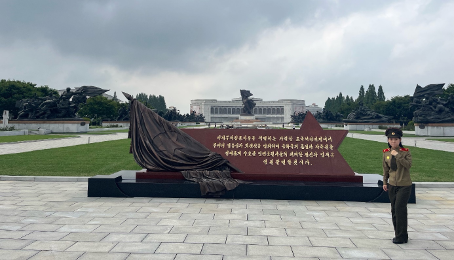
It’s like the memorial complex in Moscow on Poklonnaya Hill. Only the Koreans, unfortunately for us, came up with the idea of glorifying the Victory in this way earlier. But their “Victory Park” is not a place to rollerblade or go for a walk and have a beer with friends. No, Koreans treat their Victory with sacred awe and piety. The complex is guarded by the military, there is a roadblock in front of it, and you can get there only as part of a group, having made prior arrangements. Unless, of course, you are Kim Jong-un, who worked late and suddenly decided to come here late at night, thus greatly surprising his subordinates. Maybe that’s what Jong-un does, by the way. When it is difficult and hard for him to bear the responsibility that has been placed on him, and it is absolutely impossible to show weakness, he calls his aide-de-camp and orders: “Let’s go to the Victory Museum.” The guards and attendants are in an uproar. The museum staff, sleepy and frightened, are urgently dragged out of bed and taken to the place of pilgrimage. Or not, most likely, there are already tour guides on duty around the clock, as they are actually used to the leader’s quirks, and everything is ready for his sudden arrival.
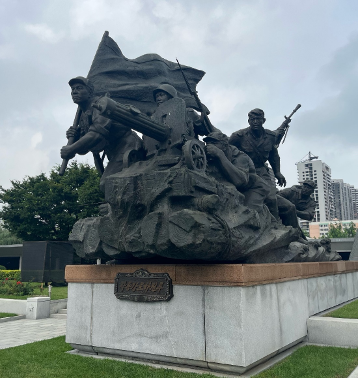
We got one such guide – a girl in a military uniform who speaks Russian well. In front of the palace there is the main monument – a Korean soldier with a banner and a PPSh submachine gun urging his comrades to go forward. To the left and right of it, closer to the entrance are group monuments of Korean fighters. Who is firing a machine gun, who is firing a cannon, who is holding a flag – all of them are striving to win, even if to die. At the exit from the museum there is also a Korean “Alyosha” saluting in a tank helmet, and here we are not the first.
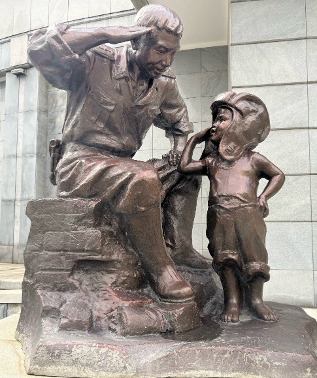
The idea of demonstrating shot down enemy vehicles also came first, unfortunately, not to us. The guide led us through the artificial trenches to the museum of pounded American equipment. The equipment is all signed, painted in khaki, with American stars and other insignia on it. Under a canopy there are a number of affected vehicles, cannons, self-propelled and armoured vehicles, howitzers on tracks, tanks and even a few planes – in front of one of them bombs of various sizes are laid out in a row – terrible weapons, hundreds, thousands of them were dropped on Pyongyang during the Korean War. There is even a helicopter. The helicopter, however, flew in much later than the Korean War, in May 1965, but to its misfortune – the photo of the pilot with a bloody back of his head is attached.
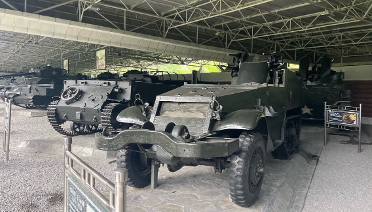
Later, in 1968, the American reconnaissance vessel “Pueblo” sailed into DPRK waters, and the Koreans seized it together with the crew – the scandal was worldwide. In case of refusal to hand over the ship and release the crew, the U.S. threatened war, lying as always, claiming that the ship was carrying geologists. But the Koreans remained adamant – to fight. So to fight, Kim Il Sung replied to the threats, ‘it was not the first time for us, but the ship was our trophy, and we would not give it to anyone’.
The ship now stands on the quay, near the museum, and a Korean sailor salutes the visitors. There is a museum on the ship – we were shown all the rooms, cabins and deckhouse, the room where the reconnaissance equipment is kept. There is also a library, most of the books are purely professional and technical, but some of the books are probably thoughtfully unwrapped spines. Maybe there’s a Wizard of OZ or Moby Dick in there, we don’t know.
We were shown a thirty-minute film about the story.
One of the American crew resisted and was killed. At first, the survivors lied and denied it, but when they were eventually ‘pushed against the wall’ and ‘to save their own skins’, they confessed everything and signed the appropriate papers. However, the handwriting is the same for some reason, but all the signatures are present.
We were not the first, and it was not the Chechens who invented the idea of making people apologise on camera – the detained Americans did not just apologise verbally, they apologised in writing. Then US President Johnson initially refused to apologise, but he had to do so to bring the tribesmen home after 11 months in a Korean prison. The footage chronicles Americans dressed as humans, in cotton jackets and caps, crossing the border on a bridge. They also handed over the corpse together with them – there is a photo with a terrible grin of the dead face.
In general, it should be said that Koreans are very proud of this story. Let Koreans are few, but very proud and they demand to be reckoned with. In my opinion, there is no precedent in the world for an American ship being seized and not given back.
On the street, from afar, I filmed a bravely marching line of soldiers. This is how they change posts – they come to a post, someone from the line comes out, and the soldier who stood down gets into a snake and they march on. The commander of the soldiers noticed that I had taken a photo, came up to the head of our group, and I had to delete the photos. You can’t take photos of the military in the DPRK.
In the main building of the museum photography and video filming are forbidden, so there will be no photos. A painted statue in inhuman height of Kim Il Sung greets the visitors of the museum. Kim Il Sung is young, wearing a white tunic and gold epaulettes. That’s who Jong-un sees when he probably comes here late at night, looking for support and encouragement. Here, grandson, this is all I have done for you and the Korean people – as if the Great Warlord is speaking.
Paintings are hung on the walls, exhibits, maps, documents are presented in numerous halls, as it is proper for such museums. But the first question that was asked and answered before us was “Who started the war in Korea?” The answer was given in a documentary film in Russian, which we were offered to watch.
Watch a military parade in Pyongyang in the following link:
https://dzen.ru/video/watch/66e44ce458b6345c97ca791f?share_to=link (Video)
From the film, we can understand that the situation was like that between us and Ukraine. The Americans were coaching, training and pumping weapons into the South. The southerners constantly arranged provocations on the border, and the northerners were forced to start their Special Military Operation, cross the 38th parallel, capture Seoul in a few days and 90% of the entire territory of South Korea. But then the Americans intervened and took a direct part in the war. It was the UN Security Council that authorised American intervention. We boycotted the meeting because China’s membership was represented by Taiwan, that is, neither China nor the USSR could block and vote against it, as in such cases. A ‘peacekeeping’ contingent was introduced into Korea, the basis of which was the Americans, and which did not act in a peacekeeping way. Pyongyang and other cities were bombed, a million Korean civilians were killed, thermite bombs – the predecessors of napalm, bacteriological and chemical weapons were used. The North Koreans had to retreat, they lost Seoul and Pyongyang, they were squeezed into the mountains. But then they got together (the girl didn’t say a word about a million Chinese holidaymakers, i.e. volunteers), conducted a number of successful military operations against the Americans, pushed them beyond the 38th parallel, even retook Seoul, or rather its ruins, and lost again. In the end, the North Koreans won by gaining a foothold on the 38th parallel.
In the newsreel there was a child, he was hysterical, standing in front of the corpse of his mother, who had been killed by bombing. After Donbass, such pictures make me fall down and bring tears to my eyes. Whatever games adults play, children should not suffer, they should not be killed or see their parents die.
It was a massacre and a horrible massacre. I understand, believe me, I can guess what happened on the Korean peninsula in 50-53.
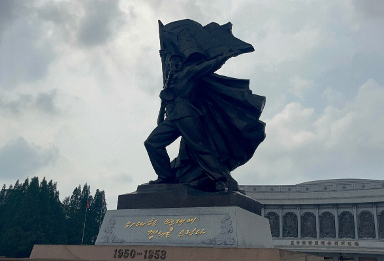
The area of the museum is 93 thousand square metres, and while telling about this war, the guide took us through different halls with installations and dioramas. We walked along partisan forest paths in summer and winter, went down to the dugouts. We were led through the hall of heroes, among whom there were Russian names (for some reason there were no Chinese).
I was impressed by two monuments in this hall, where one fighter, obviously, with broken arms holds a limonka bomb with the cheque pulled with his teeth, and another wounded man presses the trigger with his teeth, firing a machine gun. There was also a funny installation, where a blond American in a tattered overcoat stands, everywhere there is broken equipment and corpses of his comrades, one of them has a crow pecking at his body and cawing.
Then we were taken, at our request, to see the new neighbourhood. We left Pyongyang, turned near the mausoleum where Kim’s bodies are kept – this memorial complex is called the Palace of the Sun, and drove into the new neighbourhood. By the way, I noticed that when you pass the mausoleum, all cars respectfully reduce their speed.
The following link shows a video taken in the new neighbourhood: https://dzen.ru/video/watch/66e560f6c4ba0b7654039df3?share_to=link (Video)
The new neighbourhood was on the outskirts of the city, we stopped on the street. It seemed to me not easy and elite, as new buses drove here, and the neighbourhood itself looked very nice. But I was assured that both scientists with responsible comrades and ordinary workers got flats here.
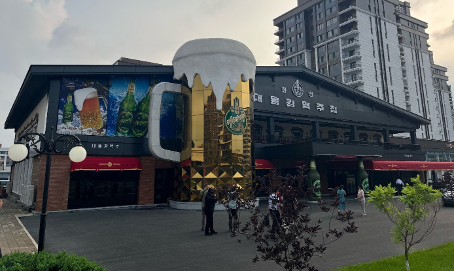
It was something like St. Petersburg’s Kudrovo or Murino, but Murino or Kudrovo, where one would like to live. The street we were walking along was called Future Street. There was a spacious road leading to the future, clean tiled pavements, green lawns of lush grass. Cycle lanes and jogging paths. Neat houses of different types, not tastelessly put together, and all of them not higher than 9 floors. All this was built in a year, the construction ended in April, 10000 flats were delivered! The housing is given from the state, absolutely free of charge, complete with furniture and utensils. You get the keys, immediately move in and live. However, we did not understand the process of renting a flat from the escort.
We didn’t get it, but to our delight we were taken to a large beer bar outside and had a mug of beer. Beer in North Korea is very tasty, it is called “Taedongan”, and in the bar it was poured in different brands from light 1 to dark 7, from wheat to rice. In general, I don’t understand why “Taedongan” is not imported to Russia or produced according to technology. North Korean beer would be an excellent competitor to European brands.
We drank the beer, snacking on chips and some fish worms, like fry, but even smaller. We asked what they were, and they said they were canaries, or in Russian – gerbils. Eh, it’s good to catch sandfish! We raised our mugs and drank to the health of the dear Chairman of State Affairs, Comrade Kim Jong-un. May God grant all workers to live in such houses.
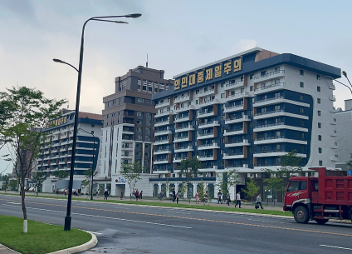
“The masses of the people are above all” – at my request, the slogan on the roof of two neighbouring houses was translated. We started the day with theory and ended it with practical examples. Everything for the masses.
To be continued…
This article was previously published in Russian here. Translation to English by UWI.








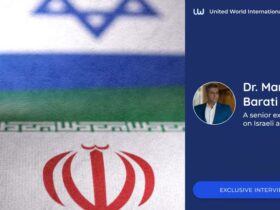
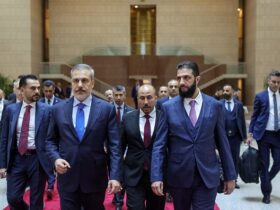


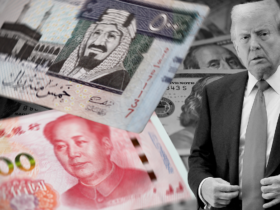
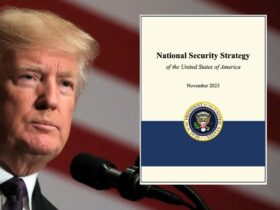
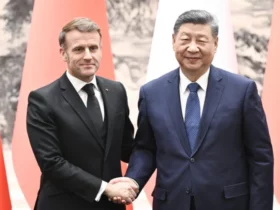


Leave a Reply